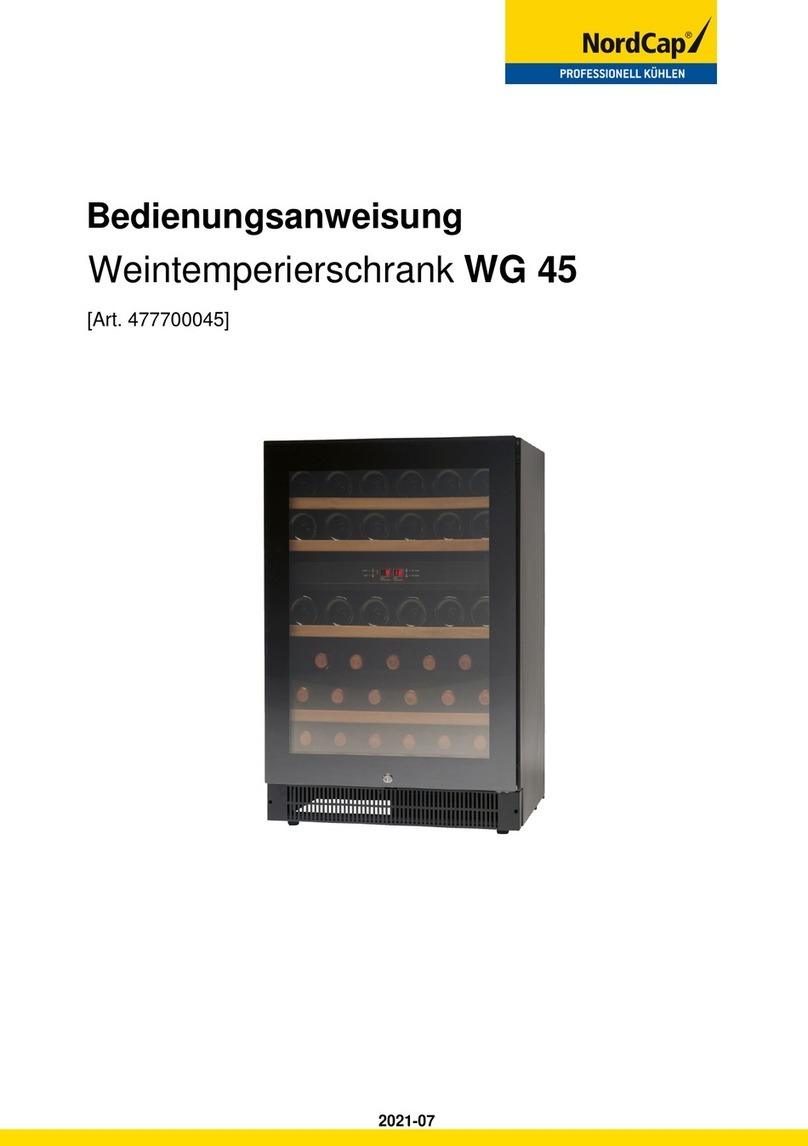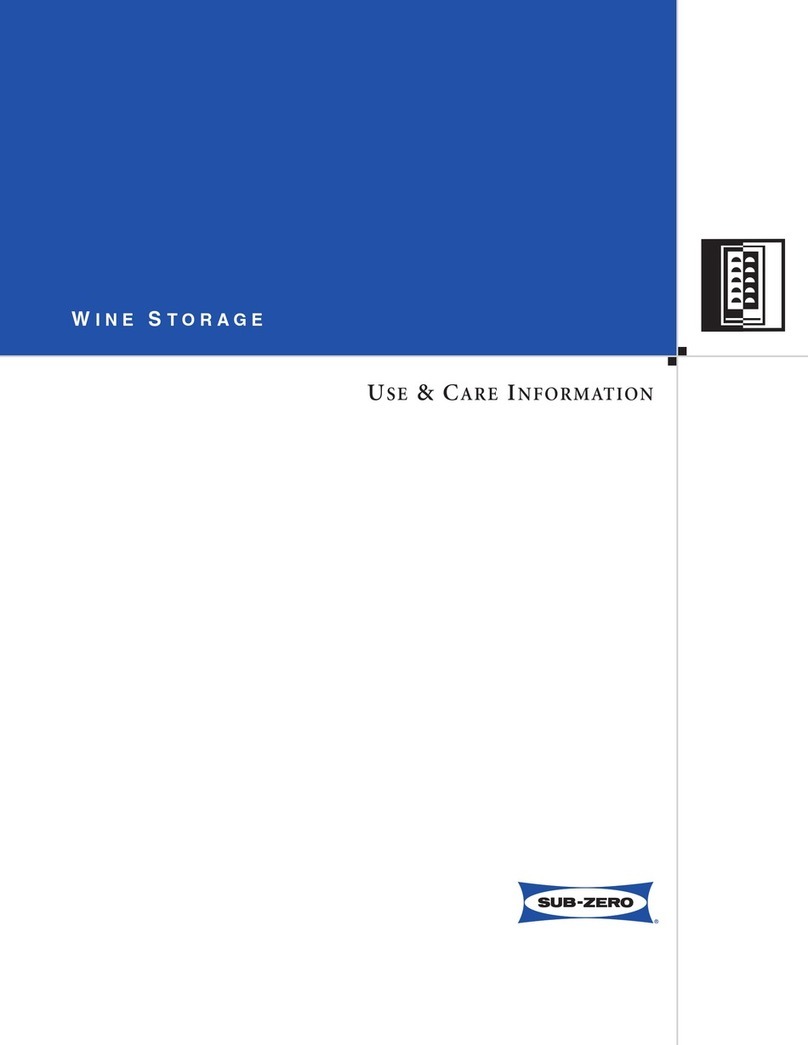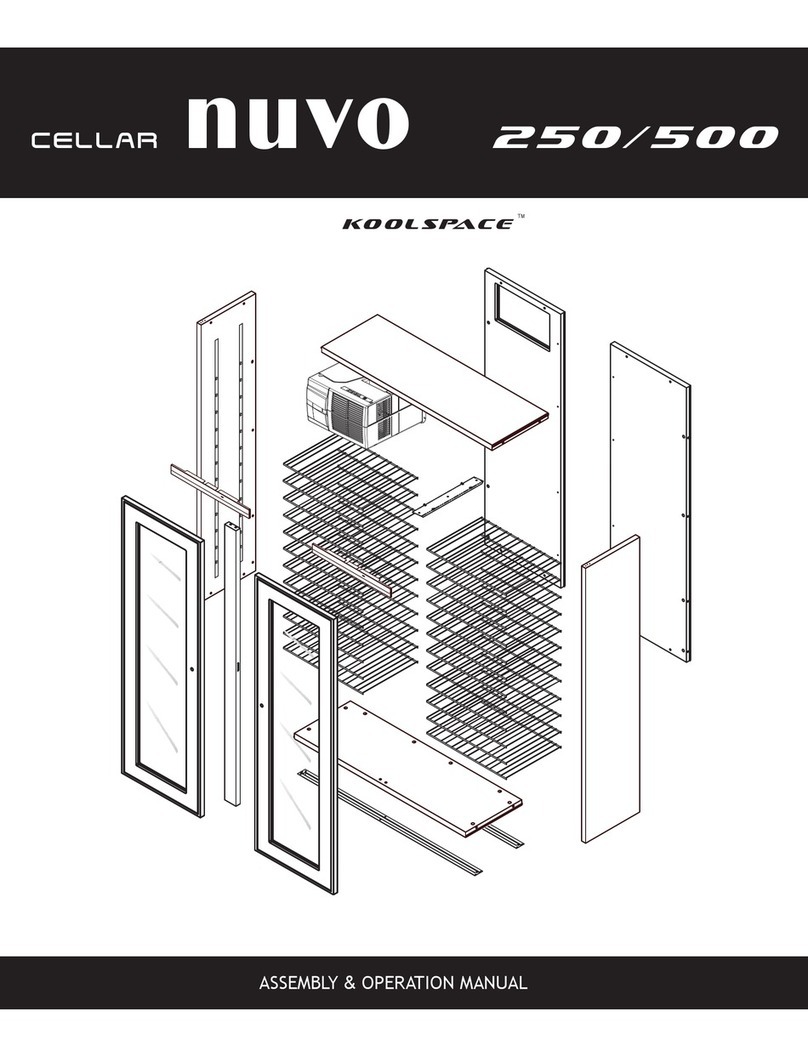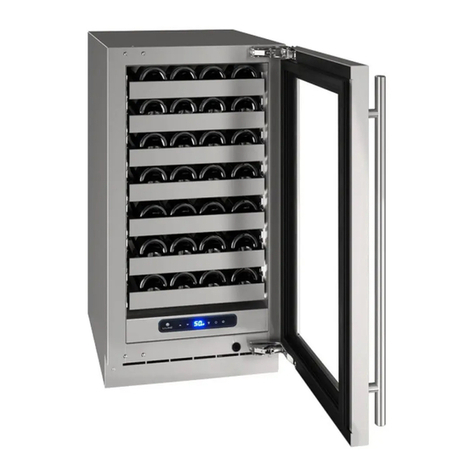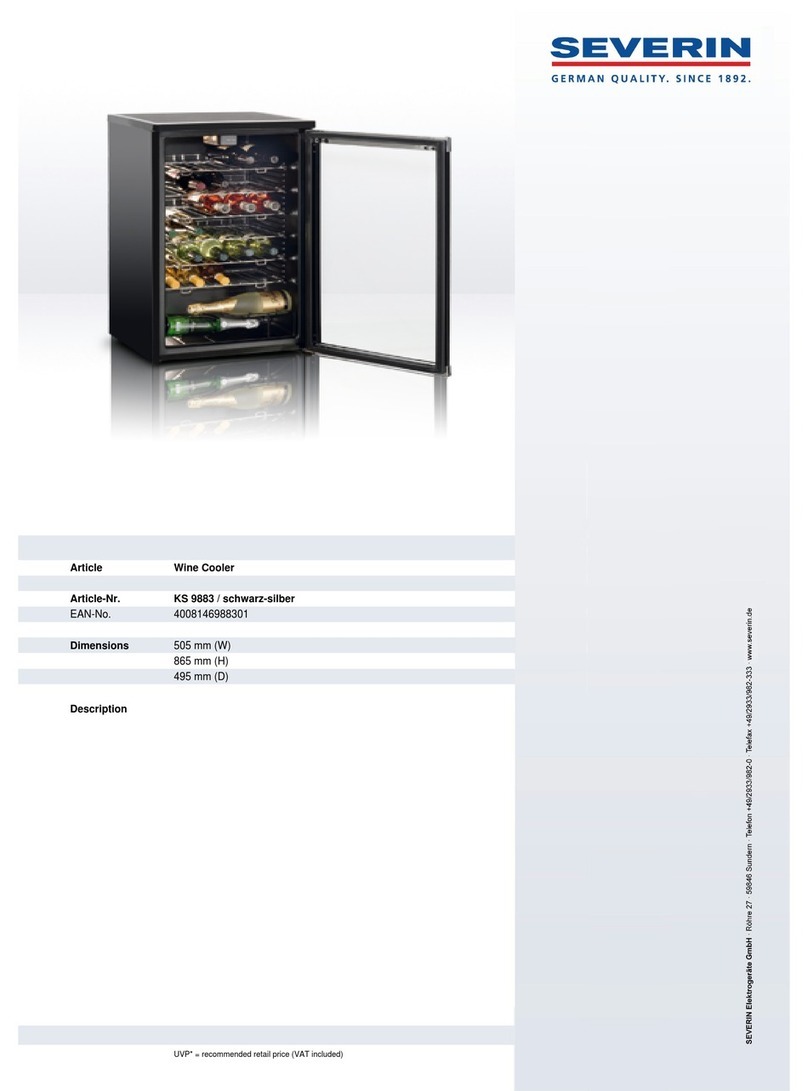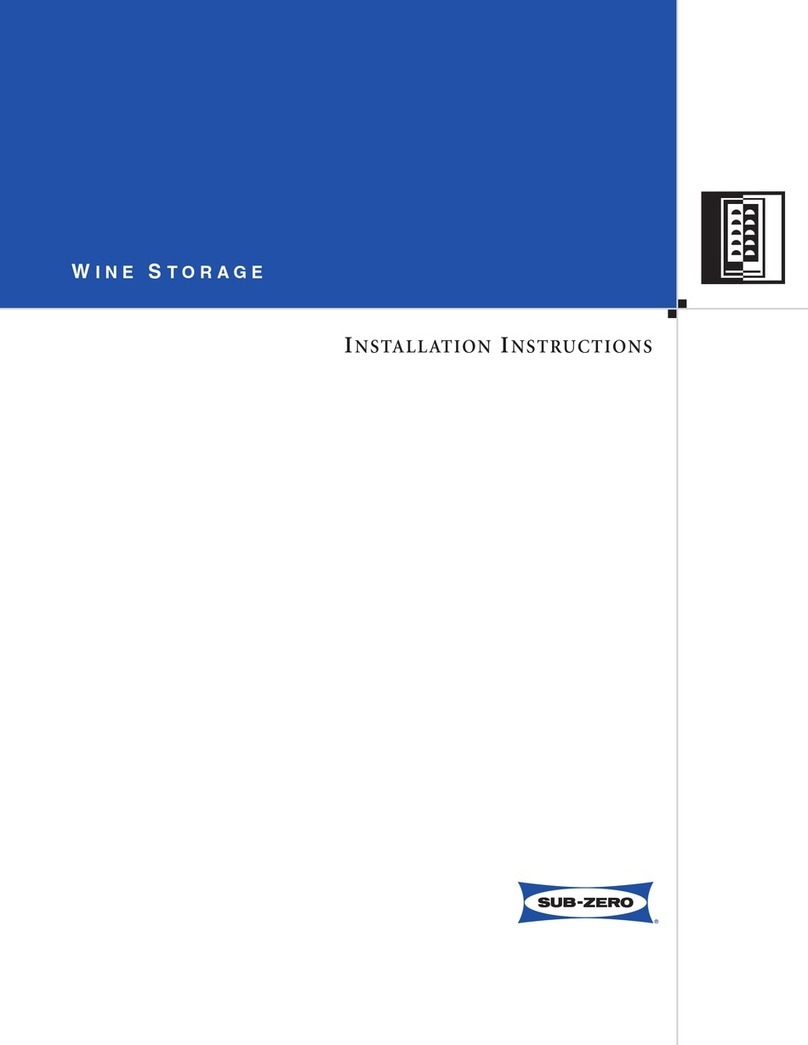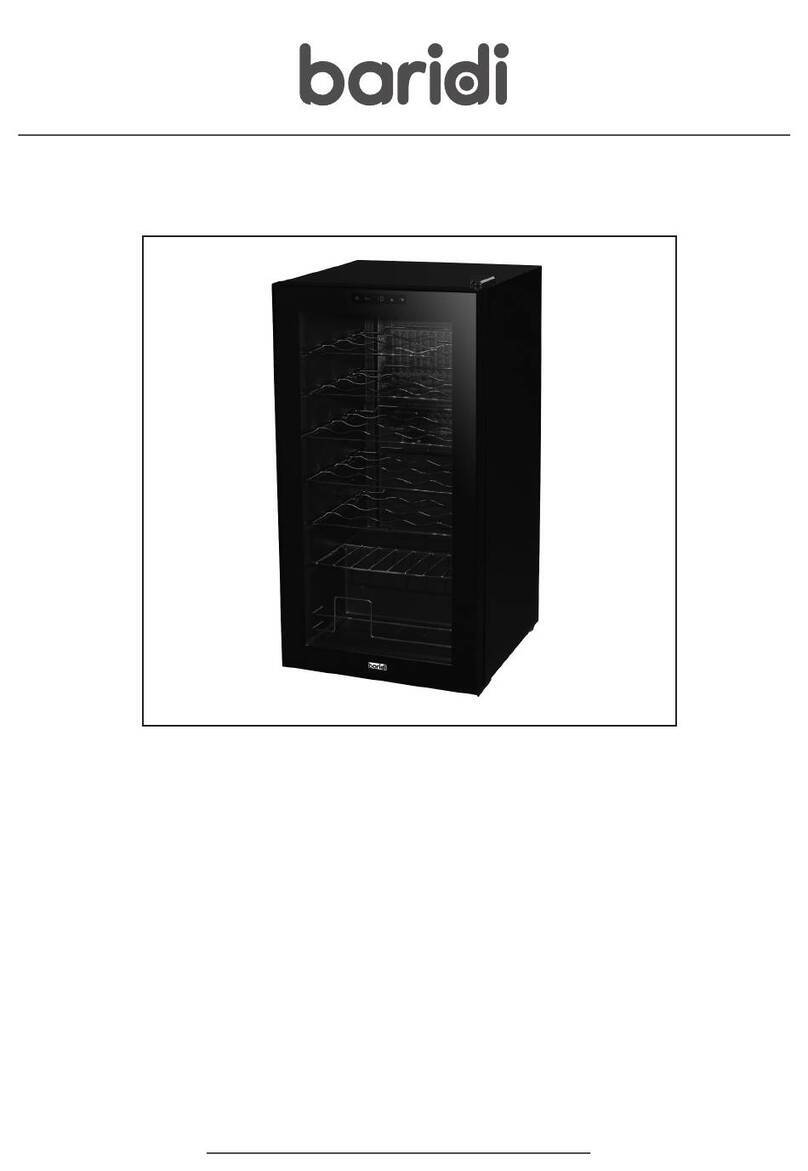Thermaster YC-409B User manual

INSTRUCTION MANUAL
WINE CELLAR
MODEL:YC-490A/YC-409B

TABLE OF CONTENTS
WINE CHILLER SAFETY 3
IMPORTANT SAFE-GUIDES 4
REFRIGERANT GAS WARNINGS 5
PARTS BREAKDOWN 7
IMPORTANT SAFETY INSTRUCTIONS 8
INSTALLATION INSTRUCTIONS 8
Before using your wine chiller 8
Installation of your wine chiller 9
Electrical connection 9
Extension cord 9
Power bar with surge protector
10
Installing stainless steel handle
10
OPERATING YOUR WINE CHILLER
11
Recommended temperature settings
11
Storage
12
Door lock
12
Cleaning your wine chiller
12
Shelves
13
Power failure
13
Moving your wine chiller
13
Energy saving tips
13
Charcoal filtration system
14
TROUBLESHOOTING GUIDE
15-16

3
WINE CHILLER SAFETY
Your safety and the safety of others are very important.
We have provided many important safety messages in this manual and on your appliance. Always read and obey
all safety messages.
This is the Safety Alert Symbol. This symbol alerts you to potential hazards that can kill or injure
you and others. All safety messages will follow the Safety Alert Symbol and either the words
“DANGER”, “WARNING” or “CAUTION”.
Danger means that failure to heed this safety
statement may result in severe personal
injury or death.
Warning means that failure to heed this
safety statement may result in extensive
product damage, serious personal injury, or
death.
Caution means that failure to heed this safety
statement may result in minor or moderate
personal injury, or property or equipment
damage.
All safety messages will alert you do what the potential hazard is, tell you how to reduce the chance of injury, and
let you know what can happen if the instructions are not followed.

4
IMPORTANT SAFEGUIDES
Before the appliance is used, it must be properly positioned and installed as described in this
manual, so read the manual carefully. To reduce the risk of fire, electrical shock or injury when
using the appliance, follow basic precaution, including the following:
Plug into a grounded 3-prong outlet, do not remove grounding prong, do not use an adapter, and do not
use an extension cord.
Replace all panels before operating.
It is recommended that a separate circuit, serving only your appliance be provided. Use receptacles that
cannot be turned off by a switch or pull chain.
Never clean appliance parts with flammable fluids. These fumes can create a fire hazard or explosion.
And do not store or use gasoline or other flammable vapour and liquids in the vicinity of this or any other
appliance. The fumes can create a fire hazard or explosion.
Before proceeding with cleaning and maintenance operations, make sure the power line of the unit is
disconnected.
Do not connect or disconnect the electric plug when your hands are wet.
Unplug the appliance or disconnect power before cleaning or servicing. Failure to do so can result in
electrical shock or death.
Do not attempt to repair or replace any part of your appliance unless it is specifically recommended in
this material. All other servicing should be referred to a qualified technician.

5
Use two or more people to move and install appliance. Failure to do so can result in back or other injury.
To ensure proper ventilation for your appliance, the front of the unit must be completely unobstructed.
Choose a well-ventilated area with temperatures above 16°C (60°F) and below 32°C (90°F). This unit
must be installed in an area protected from the element, such as wind, rain, water spray or drips.
The appliance should not be located next to ovens, grills or other sources of high heat.
The appliance must be installed with all electrical, water and drain connections in accordance with state
and local codes. A standard electrical supply (220V/50Hz), properly grounded in accordance with the
National Electrical Code and local codes and ordinances is required.
Do not kink or pinch the power supply cord of appliance.
The fuse (or circuit breaker) size should be 13 amperes.
It is important for the appliance to be leveled in order to work properly. You may need to make several
adjustments to level it.
Never allow children to operate, play with or crawl inside the appliance.
Do not use solvent-based cleaning agents of abrasives on the interior. These cleaners may damage or
discolour the interior.
Do not use this apparatus for other than its intended purpose.
FLAMMABLE REFRIGERANT GAS
DANGER - Risk of fire or explosion. Flammable refrigerant used.
DO NOT use mechanical devices to defrost refrigerator. DO NOT puncture refrigerant tubing.
DANGER - Risk of fire or explosion. Flammable refrigerant used. To be repaired only by trained service personnel.
DO NOT puncture refrigerant tubing.
CAUTION - Risk of fire or explosion. Flammable refrigerant used. Consult repair manual / owner’s guide before
attempting to service this product. All safety precautions must be followed.
CAUTION - Risk of fire or explosion. Dispose of property in accordance with federal or local regulations. Flammable
refrigerant used.
CAUTION - Risk of fire or explosion due to puncture of refrigerant tubing. Follow handling instructions carefully.
Flammable refrigerant used.
CAUTION - To prevent a child from being entrapped, keep out of reach of children and not in the vicinity of the cooler.
.
.
.
.
.
.
.
.
.
.

6
1.This appliance is not intended for use by persons (including children) with reduced physical, sensory or mental
capabilities, or lack of experience and knowledge, unless they have been given supervision or instruction
concerning use of the appliance by a person responsible for their safety.
2. Children should be supervised to ensure that they do not play with the appliance.
3. This appliance can be used by children aged from 8 years and above and persons with reduced physical,
sensory or mental capabilities or lack of experience and knowledge if they have been given supervision or
instruction concerning use of the appliance in a safe way and understand the hazards involved. Children shall not
play with the appliance. Cleaning and user maintenance shall not be made by children without supervision.
4. If the supply cord is damaged, it must be replaced by the manufacturer, its service agent or similarly qualified
persons in order to avoid a hazard.
5. To avoid a hazard due to instability of the appliance, it must be fixed in accordance with the instructions.
6. When positioning the appliance, ensure the supply cord is not trapped or damaged.
7. Do not locate multiple portable socket-outlets or portable power supplies at the rear of the appliance.
8. Keep ventilation openings, in the appliance enclosure or in the built-in structure,clear of obstruction.
9. Do not use mechanical devices or other means to accelerate the defrosting process,other than those
recommended by the manufacturer.
10. Do not damage the refrigerant circuit.
11. Do not use electrical appliances inside the drink storage compartments of the appliance, unless they are of
the type recommended by the manufacturer.
12. Do not store explosive substances such as aerosol cans with a flammable propellant in this appliance.
13. This appliance is intended to be used in household and similar applications such as
– staff kitchen areas in shops, offices and other working environments;
– farm houses and by clients in hotels, motels and other residential type environments;
– bed and breakfast type environments;
– catering and similar non-retail applications.
14. To avoid contamination of drink, please respect the following instructions:
– Opening the door for long periods can cause a significant increase of the
temperature in the compartments of the appliance.
– Clean regularly surfaces that can come in contact with drink and accessible drainage systems.
– Clean water tanks if they have not been used for 48 h, flush the water system connected to a water supply if
water has not been drawn for 5 days.
– If the refrigerating appliance is left empty for long periods, switch off, defrost, clean, dry, and leave the door
open to prevent mould developing within the appliance.

7
PARTS BREAKDOWN
Shelf
Door
Door Handle
Levelling Feet
Grille
Contorl panel

IMPORTANT SAFETY INSTRUCTIONS
WARNINGTo reduce the risk of fire, electrical shock, or injury when
using your appliance, follow these basic precautions:
.Read all instructions before using the wine chiller.
.DANGER or WARNING: Risk of child entrapment.
Child entrapment and suffocation are not problems of the past. Junked or abandoned
appliances are still dangerous.
.Before you throw away your old wine chiller, take off the door but leave the shelves in place
so that children may not easily climb inside.
.Never allow children to operate, play with, or crawl inside the appliance.
.Never clean appliance parts with flammable fluids. The fumes can create a fire hazard or
explosion.
.Do not store or use gasoline or any other flammable vapors and liquids in the vicinity of this or
any other appliance. The fumes can create a fire hazard or explosion.
-Save these instructions-
8

9
220V/50Hz
3-prong wall outlet. The cord should be secured behind the appliance and not left exposed or dangling to prevent
accidental injury.
The appliance should always be plugged into its own individual electrical outlet which has a voltage rating that
matches the rating label on the appliance. This provides the best performance and also prevent overloading
house wiring circuits that could cause a fire hazard from overheated. Never unplug the appliance by pulling the
power cord. Always grip the plug firmly and pull straight out from the receptacle. Repair or replace immediately
all power cords that have become frayed or otherwise damaged. Do not use a cord that shows cracks or abrasion
damage along its length or at either end. When moving the appliance, be careful not to damage the power cord.
Extension cord
Because of potential safety hazards under certain conditions, it is strongly recommended that you do not use an
extension cord with this appliance. However, if you must use an extension cord it is absolutely necessary that it
be a 3-wire grounding type appliance extension cord having a grounding type plug and outlet and that the
electrical rating of the cord be 220 volts and at least 13 amperes.

10
Power bar with surge protector
Most electrical appliances use a series of electric control boards to operate. These boards are very susceptible
to power surges and could be damaged or destroyed.
If the appliance is going to be used in an area or if your city / country is prone to power surges / outages; it is
suggested that you use a power surge protector for all electrical devices / appliances you use. The surge
protector that you select must have a surge block high enough to protect the appliance it is connected to. If you
have any questions regarding the type and size of surge protector needed contact a licensed electrician in your
area.
Damages due to power surges are not considered a manufacturer covered defect and will void your product
warranty.
Installing the stainless steel handle
This wine chiller includes a stainless steel handle. To install the handle please follow the below instructions:
1. Pull away the door gasket in the area where the handle is to be installed on the left side as shown below in
Illustration # 1. The gasket is easily displaced by hand, no tools are necessary.
2. Align the handle with the screws installed. Tighten the screws using a Phillips head screwdriver until the
handle sets both flush and secured tightly against the door frame. (DO NOT over tighten as this will cause
damage to the handle assembly).
3. Replace the door gasket to its original position.
4.If you choose not to use the handle supplied, simply follow step 1 to access the installation screws and
remove them and then place the two decorative plugs into the two holes separately. Continue on to step 3
to replace the door gasket to its original position.
Illustration # 1 Illustration # 2
1. Gasket 3. Phillips Head Screw Driver
2. Phillips Head Screw 4. Handle

11
OPERATING YOUR WINE CHILLER
It is recommended you install the wine chiller in a place where the ambient temperature is between 19ºC-24ºC
(66ºF-75ºF), and humidity is under 60%. If the ambient temperature is above or below recommended
temperatures, the performance of the unit may be affected. For example, placing your unit in extreme cold or
hot conditions may cause interior temperatures to fluctuate. The range of 5ºC-22ºC (41ºF-72ºF) may not be
reached.
Recommended temperature settings
Wine conservation: 12°C-14ºC (53°F-57ºF)
Rose and sparkling wines: 5°C-8ºC (41°F-46ºF)
Dry/white wines: 9°C-12ºC (48°F-53ºF)
Red wines: 14°C-18ºC (59°F-65ºF)
*Temperature ºC may varies between < + 2 ºC
YC-490A
5-22℃(40-72℉)
Turns the interior light on or off
Toggles the temperature display between Celsius and Fahrenheit
Press to begin adjusting the temperature for upper or lower zone
Adjusts the temperature in 1 degree increments
Adjusts the temperature in 1 degree decrements
Press to turn on /off the appliance

12
YC-490B
Storage
Many bottles may differ in size and dimensions. As such the actual number of bottles you may be able to store
may vary.
Door Lock
Your unit is provided with a lock and key. The keys are located inside the plastic bag that contains the Instruction
Manual. Insert the key into the lock and turn it counter clockwise to unlock the door. To lock the door do the
reverse operation making sure metal pin is engaged completely. Remove the key and place it in a secure place
for safekeeping.
Cleaning your wine chiller
Turn off the power, unplug the appliance, and remove all items including shelves. Wash the inside surfaces with a
warm water and baking soda solution. The solution should be about 2 tablespoons of baking soda to 1 cup of
water.
Wash the shelves with a mild detergent solution. Wring excess water out of the sponge or cloth when cleaning
area of the controls, or any electrical parts.
Temperature setting range:Upper zone:5-12℃(40-54℉) Lower zone:12-22℃(54-72℉)
Turns the interior light on or off
Toggles the temperature display between Celsius and Fahrenheit
Press to begin adjusting the temperature for upper or lower zone
Adjusts the temperature in 1 degree increments
Adjusts the temperature in 1 degree decrements
Press to turn on /off the appliance

13
Wash the outside cabinet with warm water and mild liquid detergent. Rinse well and wipe dry with a clean soft
cloth. Do not use steel wool or steel brush on the stainless steel. These will contaminate the stainless steel with
steel particles and rusting may occur.
Shelves
This appliance is equipped with a telescopic runner assembly (except for the bottom shelf) and you can move the
wooden shelves out and in smoothly.
To prevent damaging the door gasket, make sure to have the door all the way opened when pulling shelves out of
the rail compartment. For easy access to the bottles, you must pull the shelves approximately 1/3 out of the rail
compartment.
To remove the shelves out of the rail pull each shelf approximately 1/3 out. Use a long flat screwdriver to press
down the right plastic notch as shown in Figure A and at the same time lift the left plastic notch as shown in Figure
B. Then proceed to pull out the shelf slowly.
Power failure
Most power failures are corrected within a few hours and should not affect the temperature of your appliance if
you minimize the number of times the door is opened. If the power is going to be off for a longer period of time,
you need to take the proper steps to protect your contents.
Moving your wine chiller
-Remove all items (bottles)
-Tape down securely all loose items (shelves) inside your appliance.
-Turn the adjustable leg up to the base to avoid damage.
-Tape the door shut.
-Be sure the appliance stays secure in the upright position during transportation. If you absolutely need to
transport the chiller horizontally, transport the chiller on its back (door on top). Also protect outside of
appliance with a blanket, or similar item.
Energy saving tips
The wine chiller should be located in the coolest area of the room, away from heat producing appliances, and out
of the direct sunlight.
Figure A Figure B

14
Charcoal filtration system
Your wine is a living object that breathes through the cork of its bottle. In order to preserve the quality and taste
of your fine wines, they must be stored at the ideal temperature and ambient conditions. Your cellar is equipped
with an active charcoal filtration system to ensure air purity, cooling efficiency, and to maintain an odor free
cabinet for the storage of your fine wines. The filter assembly is located at the rear panel inside your cellar.
Keep in mind, that this filter must be changed every 12 months.
1 Remove the bottles of wine stored on the two (2)
shelves in front of the filter.
Turn Left to remove filter.
2 Remove the shelves and set aside to be replaced
once you have changed the filter
3 Hold the filter and turn it at 45 degrees in the
counter-clockwise direction and then pull it out.
4 Remove the existing filter and replace with a new
one.
5 Put the new filter into the hole and then turn the filter
at 45 degrees in clockwise direction.

15
TROUBLESHOOTING GUIDE
You can solve many common wine chiller problems easily, saving you the cost of a possible service call. Try the
suggestions below to see if you can solve the problem before calling the servicer.
PROBLEM POSSIBLE CAUSE SOLUTION
chiller does not
operate.
Not plugged in.
The appliance is turned off.
The circuit breaker tripped or a blown
fuse.
Plug the unit.
Press to turn on the unit.
Check the breaker and/or fuses.
chiller is not cold
enough.
External environment may require a
higher setting.
The door is opened too often.
The door is not closed completely.
The door gasket does not seal properly.
Check the temperature control setting.
Close the door properly.
Check the door gasket.
The compressor turns
on and off frequently.
The room temperature is hotter than
normal.
A large amount of contents has been
added to the chiller.
The door is opened too often.
The door is not closed completely.
The temperature control is not set
correctly.
The door gasket does not seal properly.
Close the door properly.
Check the door gasket.
The fans turn on and off
frequently.
In order to circulate the air and maintain the set temperature inside the cabinet the
fans must cycle on and off even when the compressor is off. The fans will cycle ON
and OFF while the compressor is off approximately every 10 seconds, this is called
“Semi-speed status”. This cycle is normal and meant both to circulate the air as
well as ensure the continued operational status of the fans. If the fan stops
completely and does not complete this cycle the fan is non-operational.
The light does not work.
Not plugged in.
The circuit breaker tripped or a blown
fuse.
The light button is “OFF”.
Plug the unit.
Check the breaker and/or fuses.

16
Vibrations.
The chiller is not leveled
The bottles are vibrating.
There is an object under the chiller.
Check to assure that the chiller is level.
Make sure the bottles don’t touch each
others.
Remove the object.
The chiller seems to
make too much noise. The chiller is not level.
Level the chiller.
The rattling noise may come from the
flow of the refrigerant, which is normal.
As each cycle ends, you may hear
gurgling sounds caused by the flow of
refrigerant in your chiller. Contraction
and expansion of the inside walls may
cause popping and crackling noises.
The door will not close
properly.
The chiller is not level.
The door was reversed and not properly
installed.
The gasket is dirty.
The shelves are out of position.
Level the chiller.
Close the door properly.
Clean the door gasket.
Place the shelves properly.
Error Code:
E1
E2
E3
Temperature sensor failure in upper zone. Contact us for a service call.
Temperature sensor failure in lower zone.
Evaporator temperature sensor failure.
Temperature sensor failure.
This manual suits for next models
2
Table of contents
Popular Wine Cooler manuals by other brands

Jenn-Air
Jenn-Air JWC2450ARB Service manual
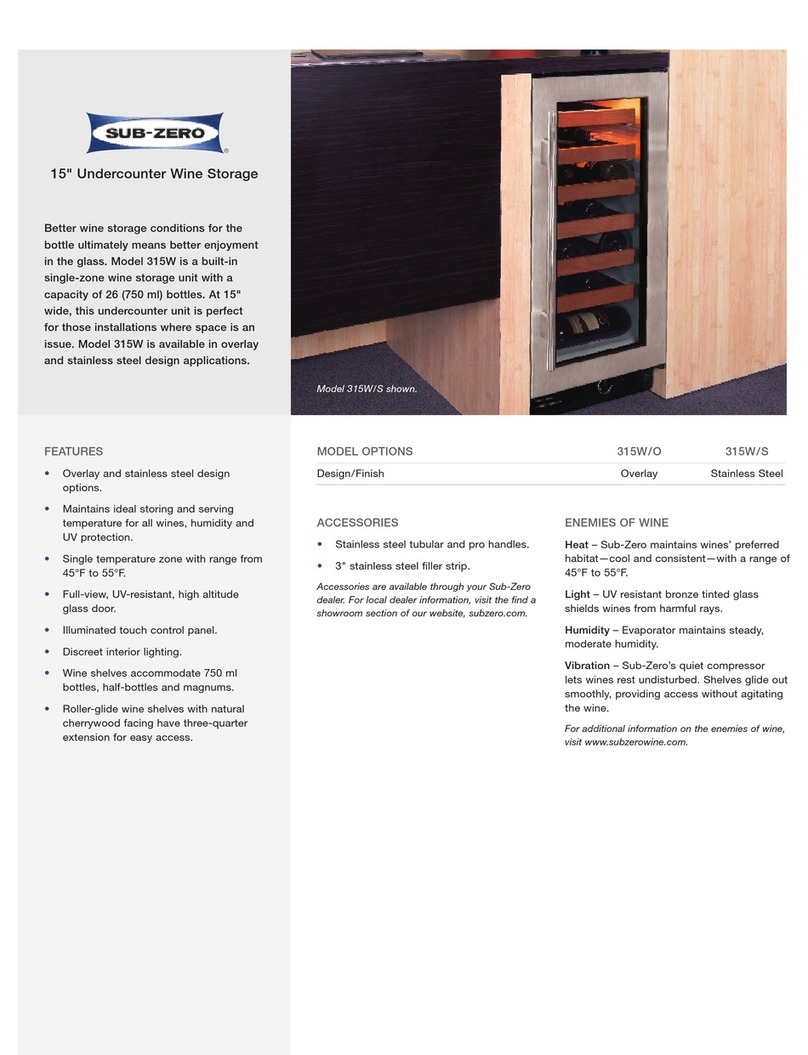
Sub-Zero
Sub-Zero 315W Specification sheet

CONTINENTAL EDISON
CONTINENTAL EDISON LA NOUVELLE CAVE CECWC24BC Instruction booklet
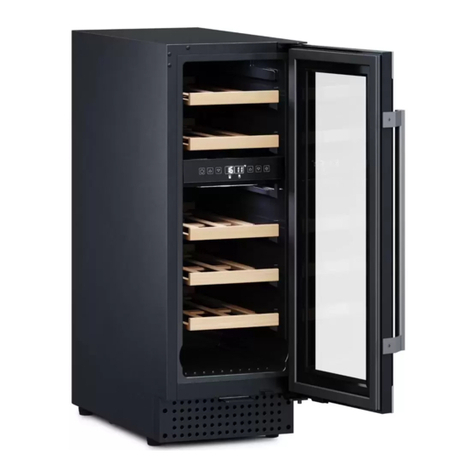
Dometic
Dometic C Series Short Installation and Operation Manual
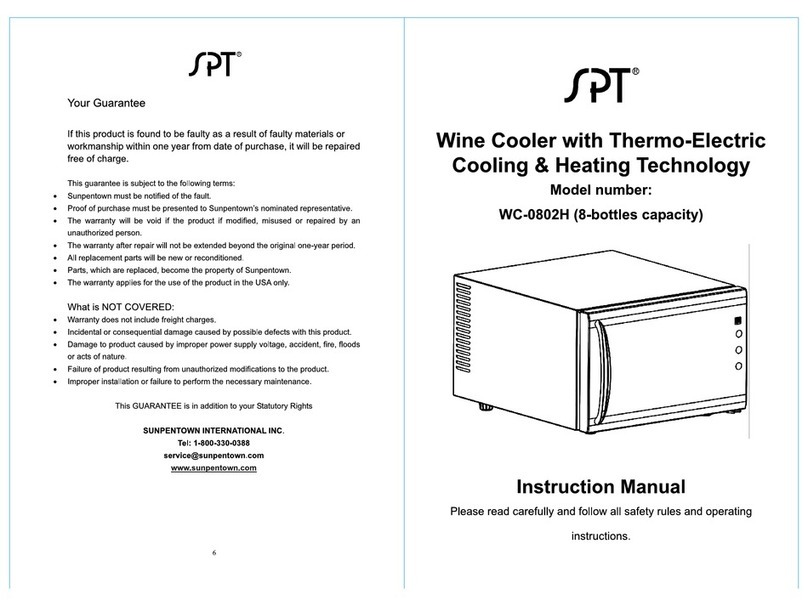
SPT
SPT WC-0802H Instruction manaul
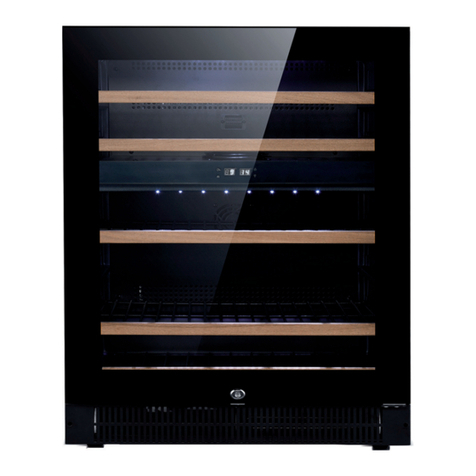
Vestfrost
Vestfrost WFG46 Instructions for use
